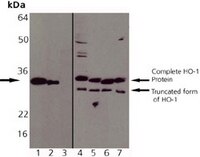374090 Sigma-AldrichAnti-Heme Oxygenase-1 (1-30) Rabbit pAb
Anti-Heme Oxygenase-1 (1-30), rabbit polyclonal, recognizes the ~32 kDa HO-1 protein. Does not cross-react with HO-2. It is validated for use in Western blotting and immunoprecipitation.
More>> Anti-Heme Oxygenase-1 (1-30), rabbit polyclonal, recognizes the ~32 kDa HO-1 protein. Does not cross-react with HO-2. It is validated for use in Western blotting and immunoprecipitation. Less<<同義語: Anti-HO-1, Anti-Hsp32
お勧めの製品
概要
| Replacement Information |
|---|
主要スペック表
| Species Reactivity | Host | Antibody Type |
|---|---|---|
| Ca, Ht, H, Mk, M, R | Rb | Polyclonal Antibody |
価格&在庫状況
| カタログ番号 | 在庫状況 | 包装 | Qty/Pk | 価格 | 数量 | |
|---|---|---|---|---|---|---|
| 374090-100ULCN |
|
樹脂アンプル | 100 ul |
|
— |
| Product Information | |
|---|---|
| Form | Liquid |
| Formulation | In PBS, 50% glycerol, pH 7.2. |
| Preservative | ≤0.1% sodium azide |
| Quality Level | MQ100 |
| Physicochemical Information |
|---|
| Dimensions |
|---|
| Materials Information |
|---|
| Toxicological Information |
|---|
| Safety Information according to GHS |
|---|
| Safety Information | |
|---|---|
| S Phrase | S: 24/25-36-A09 Avoid contact with skin and eyes. Wear suitable protective clothing. |
| Product Usage Statements |
|---|
| Packaging Information |
|---|
| Transport Information |
|---|
| Supplemental Information |
|---|
| Specifications |
|---|
| Global Trade Item Number | |
|---|---|
| カタログ番号 | GTIN |
| 374090-100ULCN | 04055977191172 |
Documentation
Anti-Heme Oxygenase-1 (1-30) Rabbit pAb (M)SDS
| タイトル |
|---|
Anti-Heme Oxygenase-1 (1-30) Rabbit pAb 試験成績書(CoA)
| タイトル | ロット番号 |
|---|---|
| 374090 |
参考資料
| 参考資料の概要 |
|---|
| Maines, M.D. 1988 FASEB J. 2, 2557. Kutty, R.K., et al. 1994. J. Cell Physiol. 159, 371. Yoshida, T., et al. 1988. Eur. J. Biochem. 171, 457. Trakshel, G.M., et al. 1986 J. Biol. Chem. 261, 11131. |








